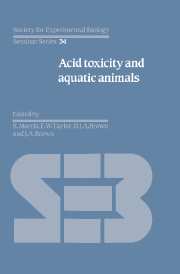Book contents
- Frontmatter
- Contents
- Contributors
- Units, Symbols and Formulae
- Preface
- Introduction: The causes and consequences of surface water acidification
- Invertebrate communities in acid streams
- Fish survival in acid waters
- Field studies on fisheries in acid waters in the UK
- Episodic changes in water quality and their effects on fish
- Acid–base regulation in fishes: 1. Mechanisms
- Acid–base regulation in fishes: 2. Biological responses and limitations
- Intracellular pH regulation and the effects of external acidification
- The physiological problems of fish in acid waters
- Laboratory studies on invertebrate survival and physiology in acid waters
- The physiological problems of crayfish in acid waters
- The effects of hydrogen and aluminium ions on fish gills
- The combined effects of pH and trace metals on fish ionoregulation
- Endocrine responses to acid stress in fish
- Commentary and conclusions
- Index
Preface
Published online by Cambridge University Press: 05 February 2012
- Frontmatter
- Contents
- Contributors
- Units, Symbols and Formulae
- Preface
- Introduction: The causes and consequences of surface water acidification
- Invertebrate communities in acid streams
- Fish survival in acid waters
- Field studies on fisheries in acid waters in the UK
- Episodic changes in water quality and their effects on fish
- Acid–base regulation in fishes: 1. Mechanisms
- Acid–base regulation in fishes: 2. Biological responses and limitations
- Intracellular pH regulation and the effects of external acidification
- The physiological problems of fish in acid waters
- Laboratory studies on invertebrate survival and physiology in acid waters
- The physiological problems of crayfish in acid waters
- The effects of hydrogen and aluminium ions on fish gills
- The combined effects of pH and trace metals on fish ionoregulation
- Endocrine responses to acid stress in fish
- Commentary and conclusions
- Index
Summary
Whilst the subject of ‘acid rain’ has received a great deal of attention from the mass media, focusing on dramatic toxic effects and the ensuing political arguments, the scientific studies have been slowly forging ahead. This book concentrates on one aspect of the problem, that of the effect of acid toxicity on the group of animals most severely affected - the aquatic animals living in fresh water.
The book results from a Symposium held at the University of Nottingham in March 1986 by the Society of Experimental Biology, when a number of scientists with expertise in this particular subject met to discuss the results of recent research into the problems. They also provided a series of articles on which this book is based. The conference was greatly helped by a financial contribution from SWAP (Surface Waters Acidification Project) – a research organisation jointly administered by the Royal Society of London, The Norwegian Academy of Science and Letters and the Royal Swedish Academy of Sciences.
The aim of the book is to cover a wide range of investigations taking place in both field and laboratory and to provide the necessary scientific background information for present and possible future approaches to the problems facing animals living in acidified fresh water. Starting initially with the environment in order to assess why problems have arisen in particular areas, the volume then deals with field and survival studies on invertebrates and vertebrates in order to examine the extent of the biological problem and the attempts which have been made to relate water quality and the susceptibility of animals.
- Type
- Chapter
- Information
- Acid Toxicity and Aquatic Animals , pp. xi - xiiPublisher: Cambridge University PressPrint publication year: 1989



